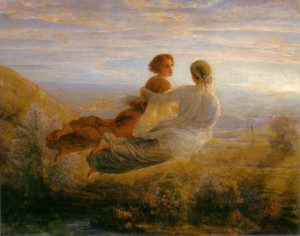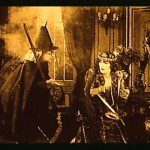In ancient Ireland, the king of a tribal territory was seen as being the husband of the local goddess, and expert members of particular professions were described as being married to the ruling goddess of that profession. For example, Senchan Torpeist, the “king of the poets,” was said to be married to a woman named Brighid — and Brighid was also the name of the goddess of poetry.

Celtic versions of the Child, Friend and Servant relationships would probably be quite similar to their Hindu counterparts. The Spouse relationship would possibly not be. Some of the deities in Irish myth are associated with a type of raw sexuality many Hindus would probably find offensive in a devotional context. Ancient Irish law recognized all forms of sexual relationship as different categories of marriage, including casual encounters like that of the Dagda with the Morrigan at the river, so a Celtic path would draw no distinction between the Spouse and Lover relationships.
Even though Hindu goddesses are sometimes portrayed with erotic imagery, many if not most bhakti practitioners strongly believe that the Lover mood may only be taken towards male deities and never toward the goddesses. In theory this is so that the devotional feeling does not become confused with the devotee’s actual sexual instincts, although there are some unexamined assumptions behind that theory. This does not seem likely to have been an attitude an ancient Irish pagan would have shared, based on the legends of goddesses who seduce human warriors, and the generally casual attitude to sex in the early sagas.
The Strength, Champion and Hound relationships are not found in bhakti.
In the Strength relationship, you would see your personal strength and power as flowing entirely from the deity. In the Champion relationship, you would see yourself as a warrior retainer in the military service of the deity. In the Hound relationship, you would see yourself as either a loyal and devoted hunting dog, or (because the word “Cuno” can mean either hound or wolf) as an outsider-warrior of the berserker type, like the reivers who called themselves “werewolves” and were devoted to a little-known form of Brighid called Brig Ambue.
Just as in bhakti, you can either focus on one of these moods exclusively or you can practice different moods at different times. In the context of Brigidine worship specifically, the type of devotional mood depends on which aspect of the goddess you intend to approach.
The Child mood would be appropriate to Brighid as “Muime,” a Gaelic word meaning “Foster Mother.” In Gaelic society, high-born children were fostered out at an early age, so they often had more intimate relationships with their foster families than their own kin, which is reflected in the fact that your biological mother is your Mathair (“mother”) while your foster mother is your Muime (“mama”). Many Gaelic folk prayers refer to Brighid as “Muime.” There are implications in bardic lore that the bards may have seen themselves as being within Brighid’s womb when they isolated themselves in dark huts to compose poetry, which would make Her their Mathair as well as their Muime.
The Parent mood is not reflected in any Celtic name I’m aware of, but Brighid is portrayed as an infant child called the Brideog at the Imbolc festival, so you can approach Her in this mood by imagining Her as the Brideog. The bards also imagined themselves as being pregnant with poetry while composing, and you could see this as an example of the Parent mood as well.
In the Friend mood, you could see yourself as the personal friend and companion of the most popular and typical aspect of Brighid- an endlessly kind, compassionate healing goddess. This aspect of Brighid is portrayed as a virgin, so you should probably not approach this aspect of the goddess in the Spouse mood as it would not be appropriate to the context. That’s why the poem in Part 1 of this series specifically refers to Her as a platonic friend.
The Strength, Champion and Hound moods might be most appropriate for either Brig Brethach or Brig Ambue. Brig Brethach was an obscure aspect or avatar of Brighid, a female judge in ancient Ireland who gave judgments defending the legal rights of women. Brig Ambue was also a female judge who gave judgments on behalf of the Ambue or “cowless” class, the economically and politically dispossessed of ancient Ireland. Activists for woman’s rights, social justice and economic equality could approach Her as the source of their Strength, as Champions of Her cause, or as Her outsider Wolves.
The Spouse relationship would be appropriate for Great Brid of the Horses, the spouse of the “king poet” Senchan Torpeist. This mood is a good one for exploring the sense of yearning the divine power inspires, the often painful sense of separation during periods of “spiritual dryness,” and the almost flirtatious way in which the deity’s delightful presence appears and disappears without warning:
I’ve been dreaming about You
A lot lately,
But I can’t remember the dreams.
Sometimes it seems
I’ve spent the whole night
In Your presence,
Only to lose You upon waking.
I’ve been aching for some kind of
Word from You,
Although I’ve heard from You constantly.
It’s almost as if You’re playing games with me…
Finally, the Servant relationship is appropriate for Brighid in all Her forms, and was probably the most common one based on the frequency of names like Giolla Bride and Maelbrighde.
By approaching the goddess Brighid (or any other deity) through these devotional moods, you can cultivate a relationship of true love and intense emotional power, a relationship that goes far beyond conducting a meticulously planned-out ritual. You can experience the mystical ecstasy of total devotion to the divine.
Loop of Brighid is published on alternate Thursdays. Follow it via RSS or e-mail!

















